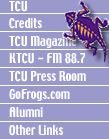|
Friday,
September 28, 2001
Bush
reveals plan to improve airline security
By Scott Lindlaw
Associated Press
CHICAGO
— President Bush sought to coax Americans back onto airplanes
Thursday by putting the federal government in charge of airport
security and pledging $500 million to upgrade security features
on airplanes in hopes of thwarting future hijackings.
Bush
urged governors to call up National Guard units to protect
U.S. airports while he implements a long-term airline security
plan.
 |
Dale
Guldan - Milwaukee Journal Sentinel
President
George W. Bush speaks to a crowd gathered at O’Hare
International Airport in Chicago, Ill. Thursday. The
airport has resumed many of its daily flights.
|
“Get
on the airlines, get about the business of America,”
Bush told hundreds of flag-waving airline workers at O’Hare
International Airport. Two jets were parked nose-to-nose at
the event — one each from United Airlines and American
Airlines, the carriers hijacked two weeks ago. The attacks
left nearly 7,000 dead or missing.
Bush
found a message in the two corporate logos: “America
is united!” he said. “We are united in bringing
justice to those folks who did the evil deed on Sept. 11.”
As he spoke, departing jets roared overhead.
“We
will not surrender our freedom to travel. We will not surrender
our freedoms in America,” Bush said, his voice rising
to a shout. “You may think you have struck our soul,
you haven’t touched it!”
Terrorists
hijacked four airplanes Sept. 11, crashing two into the World
Trade Center in New York and one into the Pentagon outside
Washington. A fourth crashed in Pennsylvania, apparently after
passengers struggled with the hijackers. U.S. air travel has
dropped sharply since the attacks.
“The
American people are going to get back on your airplanes. They
will, believe me, they’ll be back on your planes,”
said Illinois Gov. George Ryan.
“I
want to encourage people to take that business trip or the
long-awaited vacation they have planned,” said Chicago
Mayor Richard Daley, drawing a roar of appreciation from the
workers.
Bush’s
plan includes:
- Expanding
the use of federal air marshals aboard commercial airliners.
“The requirements and qualifications of federal air
marshals are among the most stringent of any U.S. federal
law enforcement agency,” the White House said.
- Spending
$500 million on plane modifications, including efforts to
restrict the opening of cockpit doors during flights, fortify
cockpit doors to deny access from the cabin, alert the cockpit
crew to activity in the cabin and ensure continuous operation
of the aircraft transponder in the event of an emergency.
The transponder allows air controllers to track a plane.
- Putting
the federal government in charge of airport security and
screening, including the purchase and maintenance of all
equipment. The government would supervise passenger and
baggage security and perform background checks on security
personnel. Uniformed federal workers would manage all operations;
federal and nonfederal workers would share the security
work. Many airport security workers would remain in the
employ of private companies, but with increased oversight
by the federal government.
Bush
said he would invest in technologies that allow pilots to
monitor passenger cabins by video camera, and let control
towers take over “distressed” aircraft by remote
control.
“Fully
implementing the extensive security proposal may take four
to six months,” the White House statement said. “During
that time, the president will help ensure that every airport
has a strong security presence by asking the governors of
the 50 states to call up the National Guard — at the
federal government’s expense — to augment existing
security staff at every commercial airport nationwide.”
White
House officials said Bush also hopes to reopen Reagan National
Airport outside Washington, the only airport still closed
due to the Sept. 11 attacks, but is not yet convinced that
flying there would be safe, aides said.
Bush’s
plan does not include arming pilots, action requested by the
pilots themselves. “There may be better ways to do it
than that, but I’m open for any suggestion,” Bush
said Wednesday, as aides privately confirmed that he is cool
to the idea.
Transportation
Secretary Norman Mineta flew to Chicago aboard a commercial
flight to demonstrate his confidence in the air system. He
was accompanied by Jane Garvey, head of the Federal Aviation
Administration.
Mineta
waited in a long line at a BWI security checkpoint. He placed
a leather bag on a scanner’s conveyor belt, took out
his keys and walked through the metal detector. It beeped,
prompting a security guard to give Mineta a thorough sweep
with a hand-held detector before allowing him onto Concourse
A.
Mineta
called the system safe, secure and stable.
Bush’s
father, the nation’s 41st president, boarded a commercial
flight in Boston for a trip to Houston, accompanied by several
Secret Service agents.
White
House spokesman Ari Fleischer said the number of commercial
flights each day had returned to near normal, now at about
5,500, compared with the maximum before the attacks of 6,500.
However,
relatively few people are on those flights. Delta Air Lines,
for example, says its planes typically are only 35 percent
filled.
|
